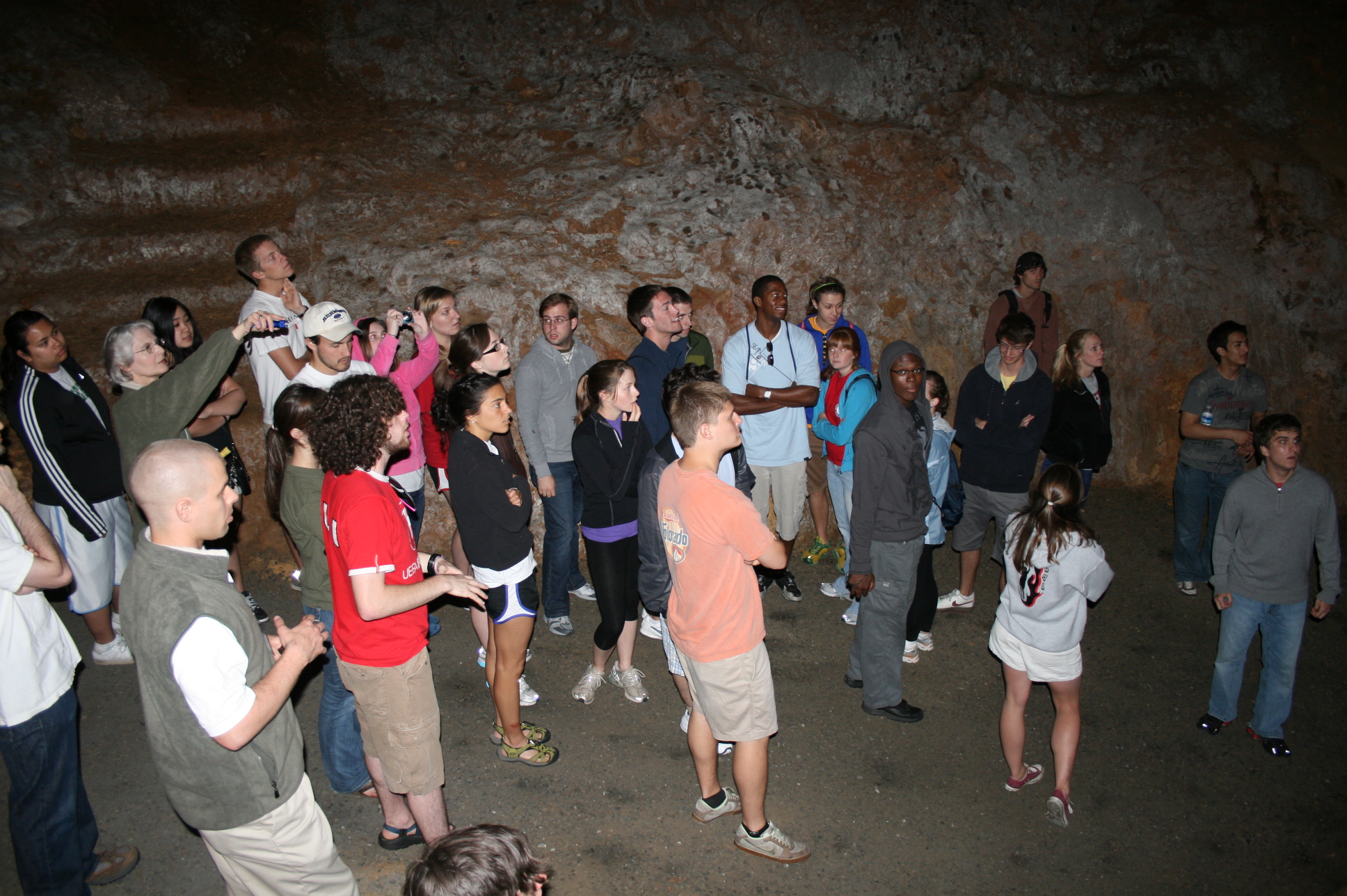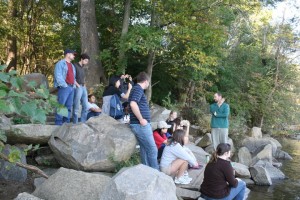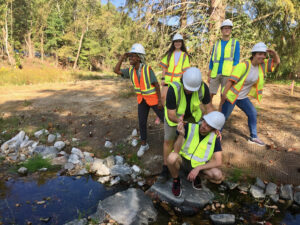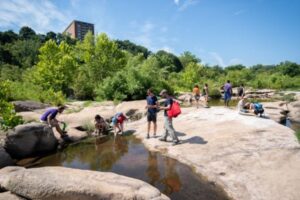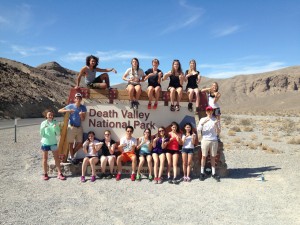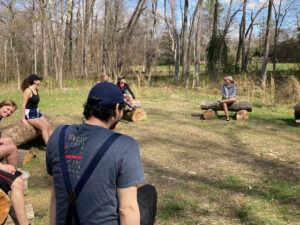Most courses follow a community-based learning model. More opportunities to engage with the local environment in Richmond can be found at the Center for Civic Engagement’s Environment webpage.
Planet Earth: Wind, Water, Fire
The Earth is changing in unprecedented ways. This course introduces the characteristics and interrelationships of the Earth’s climates, landforms, soils, and natural vegetation, with special emphasis on human relationships with their environment. A geographic approach emphasizes interconnectedness and spatial components of these relationships. The subject matter is particularly relevant to current social and scientific interest in global climate change and the spatial inequalities in environmental pollution and resources that benefit some communities and disadvantage others. The course is divided into five units: (1) concepts and tools of physical geography, (2) air (wind), (3) water, (4) landforms (fire), and (5) biodiversity.
We will take a systems perspective and sequentially study each of these separate systems in turn, emphasizing linkages between the Earth’s systems. Human and other components of the biosphere will be discussed throughout the semester. The material is global in scale, though we will illustrate many of the concepts using local examples from campus and the city of Richmond.
Next taught: Fall 2025
Geography of the James River Watershed
The course has three primary objectives: (1) to provide students with an introduction to physical geography by thinking about scale, connectivity and boundaries, (2) to exercise and hone skills of critical observation, and (3) to connect the theory learned in class to the practice of natural resource management in the local community.
These goals are accomplished by getting out of the classroom and getting first-hand exposure to the people and environments that define the resource challenges and opportunities within the James River watershed. The course begins with a field trip on the river in which initial impressions of the region’s natural resources will be made. These impressions are deconstructed in class as part of the core lecture material. During the rest of the semester we work with a local practitioner on projects related to conservation in the watershed. These independent projects vary from year to year. For example, in one year the class worked with the James River Park System on projects including improved mapping of the park and treatment of invasive plants in the park. Local experts on the watershed also participate in the course as guest lecturers. A final project ties together the lecture and field-based components of the course.
Course Photo Albums: Huguenot Flatwater, Portland, Presquile Isle National Wildlife Refuge, Dutch Gap, Sturgeon Cruise, Potomac River, Downtown Richmond, Holliday Lake, Congaree
Next taught: Spring 2025
Landscape Ecology
Landscape ecology is an applied science that focuses on the development, consquences and management of environmental patterns. These patterns include the spatial distributions of species and the environment resources upon which they depend. Although the focus is typically on relatively large landscape units, careful attention is paid to the importance of scale in natural resource management. Because nearly all of the earth’s landscapes have been altered by human activities for some time, landscape ecology also emphasized the role of humans in the environment. The goal of this course is to give students a firm grasp of the concepts of landscape ecology and how these concepts can be applied to enhance the effectiveness of environmental policy, assessment and management.
The course uses a combination of lectures, discussions, homework assignments, and special projects to study topics including: fragmentation and land-use change; characteristic spatial and temporal scales of ecological processes; methods for describing spatial variability in the physical and biological environment; the role of disturbance in shaping environmental patterns; and the applications of landscape ecology to monitoring, conservation and restoration (with special emphasis on human-modified environments).
Course Photo Albums: Eco-Corridor, Richmond National Battlefield
Next taught: Spring 2025
Future Cities and the Environment
 Course Description:
Course Description:
By the year 2050, more than two-thirds of the world’s population will live in urban settings. Sustaining the demand for clean water, healthy air, and flourishing natural ecosystems to equitably support these cities will be one of society’s greatest challenges.
This course examines the physical and social challenges to creating thriving, equitable environments in modern cites through comparative analysis of our local environment in Richmond, Virginia to two cities with some of the highest wealth inequality in the world: Cape Town and Durban, South Africa. The three-week immersive Maymester program focuses on issues of clean water, healthy air, and access to nature. The course is divided into four parts: (1) spring semester introduction to issues with emphasis on our local campus, (2) one week living in Downtown Richmond studying themes of environmental history, healthy air, clean water, accessible nature, and flourishing ecosystems, (3) one week living in Cape Town studying the environmental history associated with apartheid, the Day Zero water crisis, and local ecosystems, and (4) one week living in Durban studying air toxicity, water access, and the challenges of maintaining biological diversity. The final product is a comparative analysis of a specific environmental challenge for two cities, including proposed solutions.
Course Photo Albums: Richmond, Cape Town
Next taught: Spring 2026
Biogeography
The Earth is in the midst of its sixth mass extinction event. Why is this happening? What can we expect the future to look like? What can be done? Biogeography is the study of the Earth’s biological diversity, the spatial distribution of species, and how these distributions change over time. The science combines basic concepts in ecology and geography. This course provides a foundational understanding of biogeography and assesses the relevance of biogeography during a time of increasing human impact, globalization, and climate change. The varying influences on species distributions in different ecosystems and different regions of the world will be critically examined to assess future opportunities for conservation.
Biogeography draws from a broad range of basic science (macroecology, evolutionary biology, ecosystem science, climatology, geology, ecoinformatics) and applied disciplines (global change biology, invasion ecology, environmental health, conservation). Topics considered range from evolutionary mechanisms, earth history, and plate tectonics to concepts of ecological niche theory and basic taxonomy. This course examines both historical and contemporary patterns of species distributions. It includes the study of current and future threats to species and the evaluation of potential conservation actions to mitigate threats. Through homework assignments and a final project, special emphasis will be placed on comparing the influences on biological distributions in an urban environment (Richmond, Virginia) vs an old-growth forest (Blue River, Oregon).
Environmental Gradients
Course Description:
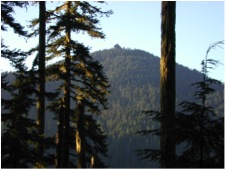 This class focuses on the approaches, key concepts, and methods of environmental modeling. Understanding the relationships between spatial gradients (e.g., between the distributions of species abundance and temperature) is essential to predicting responses to environmental changes such as those predicted under global warming scenarios. We begin with a discussion of the challenges inherent to describing environmental systems quantitatively. These issues will be revisited throughout the semester and will help guide our class assignments. The remainder of the course is divided into four units, each focusing on a different environmental system: soil nutrients, climatic, hydrologic and biotic. A modeling approach is introduced and different types of conceptual, statistical and simulation models are used to explore the different systems. Class exercises are developed for well-studied Long-Term Ecological Research (LTER) sites in the southeast and northwest United States. The final project requires the development of a spatial distribution model based on tools learned in the course.
This class focuses on the approaches, key concepts, and methods of environmental modeling. Understanding the relationships between spatial gradients (e.g., between the distributions of species abundance and temperature) is essential to predicting responses to environmental changes such as those predicted under global warming scenarios. We begin with a discussion of the challenges inherent to describing environmental systems quantitatively. These issues will be revisited throughout the semester and will help guide our class assignments. The remainder of the course is divided into four units, each focusing on a different environmental system: soil nutrients, climatic, hydrologic and biotic. A modeling approach is introduced and different types of conceptual, statistical and simulation models are used to explore the different systems. Class exercises are developed for well-studied Long-Term Ecological Research (LTER) sites in the southeast and northwest United States. The final project requires the development of a spatial distribution model based on tools learned in the course.
Protected Lands of the American West
How do we balance competing demands for our nation’s most precious natural resources? Many of our protected lands in the United States were set aside because of their natural beauty but also because they were viewed as lands of minimal value for development. Yet, there has always been a tension between goals of conservation for future generations and the current use of resources on these lands. We explore the spatial distribution of natural resources in the west and the potential conflict among different stakeholders to extract and conserve these resources. Course goals are accomplished through a combination of five in-depth case studies and first-hand exposure to the people and environments that define the debate.
In this Sophomore Scholars in Residence course, a case study approach is used to consider issues of water demand, forestry, energy development, food production, and mining. Local field trips to the James River Park System and Richmond National Battlefield are used to form initial impressions of the challenges confronting responsible natural resource stewardship. During a fall break trip, we visit different types of public lands along a 10,000-foot elevation transect from Las Vegas, Nevada to Yosemite National Park, California. The class concludes with client-based independent study projects in the spring semester.
Course Photo Albums: 2015, 2014
Senior Capstone
This course is the culmination of the Environmental Studies and Geography majors. The primary objective is to further develop students’ ability to conduct interdisciplinary research through the practical application of disciplinary specific methods and theory. Students work independently but in project teams to address applied environmental challenges such as the developing stewardship plans for the Gambles Mill Eco-Corridor on campus and creating strategies to address Richmond’s urban heat island effect. As part of the capstone project work, seniors synthesize knowledge and skills gained from during their educational journey at UR through the close study of a current environmental problem, culminating in an individual report conducted within the framework of a group project.
Teaching Articles
Community-Based Learning for a Day
Spiders Across Disciplines Research Global Ecosystems
Lets Talk Let’s Talk Sustainability: Opportunities to learn about sustainability in UR courses
Eco-Corridor to Provide Creek Access and Experiential Learning Opportunities
UR Participates in University Innovation Fellows Program for the First Time
Change Agents: Students Named Global Innovation Leaders
Faculty Transform Their Classes for a Hybrid Learning Environment
Hot Spots: UR Student Researchers Help in the Fight Against Extreme Heat UR
Innovative International Programs Ensure Spiders Experience the World
New “Maymester” Course Includes South Africa Trip
Tree Mapping Project Shows a Dynamic New View of Campus
Lessons in Nature on the University of Richmond Campus
University of Richmond Receives Green Honors
UR Community Gathers to Plant and Care for an Edible Landscape

